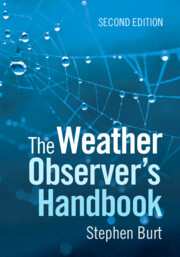102 results
Part I - The basics
-
- Book:
- The Weather Observer's Handbook
- Published online:
- 21 May 2024
- Print publication:
- 25 April 2024, pp 1-84
-
- Chapter
- Export citation
Part III - Making the most of your observations
-
- Book:
- The Weather Observer's Handbook
- Published online:
- 21 May 2024
- Print publication:
- 25 April 2024, pp 361-441
-
- Chapter
- Export citation

The Weather Observer's Handbook
-
- Published online:
- 21 May 2024
- Print publication:
- 25 April 2024
Appendix 5 - Useful functions
-
- Book:
- The Weather Observer's Handbook
- Published online:
- 21 May 2024
- Print publication:
- 25 April 2024, pp 475-477
-
- Chapter
- Export citation
Epigraph
-
- Book:
- The Weather Observer's Handbook
- Published online:
- 21 May 2024
- Print publication:
- 25 April 2024, pp vi-vi
-
- Chapter
- Export citation
Appendix 6 - Unit conversions
-
- Book:
- The Weather Observer's Handbook
- Published online:
- 21 May 2024
- Print publication:
- 25 April 2024, pp 478-480
-
- Chapter
- Export citation
Appendix 3 - Useful sources
-
- Book:
- The Weather Observer's Handbook
- Published online:
- 21 May 2024
- Print publication:
- 25 April 2024, pp 459-467
-
- Chapter
- Export citation
Author’s note
-
- Book:
- The Weather Observer's Handbook
- Published online:
- 21 May 2024
- Print publication:
- 25 April 2024, pp xii-xii
-
- Chapter
- Export citation
Appendices
-
- Book:
- The Weather Observer's Handbook
- Published online:
- 21 May 2024
- Print publication:
- 25 April 2024, pp 442-480
-
- Chapter
- Export citation
15 - Calibration
- from Part II - Measuring the weather
-
- Book:
- The Weather Observer's Handbook
- Published online:
- 21 May 2024
- Print publication:
- 25 April 2024, pp 335-350
-
- Chapter
- Export citation
8 - Measuring humidity
- from Part II - Measuring the weather
-
- Book:
- The Weather Observer's Handbook
- Published online:
- 21 May 2024
- Print publication:
- 25 April 2024, pp 204-216
-
- Chapter
- Export citation
References and Further Reading
-
- Book:
- The Weather Observer's Handbook
- Published online:
- 21 May 2024
- Print publication:
- 25 April 2024, pp 481-500
-
- Chapter
- Export citation
Acknowledgements
-
- Book:
- The Weather Observer's Handbook
- Published online:
- 21 May 2024
- Print publication:
- 25 April 2024, pp x-xi
-
- Chapter
- Export citation
10 - Measuring grass and earth temperatures
- from Part II - Measuring the weather
-
- Book:
- The Weather Observer's Handbook
- Published online:
- 21 May 2024
- Print publication:
- 25 April 2024, pp 251-262
-
- Chapter
- Export citation
Index
-
- Book:
- The Weather Observer's Handbook
- Published online:
- 21 May 2024
- Print publication:
- 25 April 2024, pp 501-506
-
- Chapter
- Export citation
Contents
-
- Book:
- The Weather Observer's Handbook
- Published online:
- 21 May 2024
- Print publication:
- 25 April 2024, pp vii-viii
-
- Chapter
- Export citation
16 - Metadata: What is it, and why is it important?
- from Part II - Measuring the weather
-
- Book:
- The Weather Observer's Handbook
- Published online:
- 21 May 2024
- Print publication:
- 25 April 2024, pp 351-360
-
- Chapter
- Export citation
Dedication
-
- Book:
- The Weather Observer's Handbook
- Published online:
- 21 May 2024
- Print publication:
- 25 April 2024, pp v-v
-
- Chapter
- Export citation
3 - Buying a weather station
- from Part I - The basics
-
- Book:
- The Weather Observer's Handbook
- Published online:
- 21 May 2024
- Print publication:
- 25 April 2024, pp 58-84
-
- Chapter
- Export citation
14 - Non-instrumental weather observing
- from Part II - Measuring the weather
-
- Book:
- The Weather Observer's Handbook
- Published online:
- 21 May 2024
- Print publication:
- 25 April 2024, pp 324-334
-
- Chapter
- Export citation

